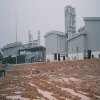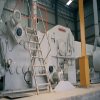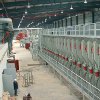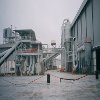Mieco keeps on growing
16 March 2005Mieco Chipboard is a name that is very well known in the Asian panel industry, both for raw particleboard (chipboard) production and for its extensive valueadding facilities, having launched its first production line in 1976.
The company in fact has two established particleboard mills, both in Kuantan in Pahang state on the east coast of peninsula Malaysia. One line is at Semambu and the other at Gebeng.
The combined capacity of these two lines is over 280,000m3 a year on one Siempelkamp continuous ContiRoll press and one Dieffenbacher single-opening one.
Mieco is owned 56% by Bandaraya Development Bhd, while 44% is publicly owned, with a listing on the Kuala Lumpur stock exchange in 1998.
The company’s latest project is situated on a greenfield site in Kuala Lipis in the northern part of the Malaysian peninsula, 270km north of the capital, Kuala Lumpur, for reasons which soon become obvious, given concerns about material supply in the peninsula.
“Our nearest competitor is Robin Resources in Mentakab in terms of wood raw material and we have 11 sawmills around here and a number of rubberwood plantations,said Dato’ Yong Seng Yeow, executive director of Mieco Chipboard Berhad. “We are also close to Gua Musang and there are huge forests there of medium hardwood, rubberwood and acacia, 90 minutes from the factory.
“We don’t depend much on logs, but use sawmill residues, shavings and sawdust – logs only comprise about 15-20% in the form of branches and thinnings.
“We have no worries about wood supply here.We considered building the new line in China, Vietnam or elsewhere, but decided on Kuala Lipis because of the wood supply,confirmed Dato’ Yong.
State encouragement
Pahang state is also encouraging the development of a wood products industry and Mieco is the first company to take advantage of that.
Acacia may be a good wood for panel production, but its stringy bark is a problem for conventional debarkers and Mieco is of course aware of that.
“A Brazilian company has developed a debarker which can cope with acacia and a couple of mills are already using it successfully, so we will be buying one of those,said the executive director.
Raw material supply is particularly relevant for Mieco’s latest project where the initial output will be 1,500m3 per day and will reach 2,000m3 a day later.
Vanachai of Thailand still holds the crown of the biggest capacity manufacturer of the product in the Asia-Pacific, at just under one million m3 annually, but Mieco is obviously a major regional player.
At the time of my visit in early December, the 50-acre site was being treated to one of those continual rainstorms that only the rainy season here can offer and areas of water were seen on the open expanses of the site.
However, inside the buildings, the new line was nearing completion, with technicians adding the finishing touches.
A conveyor system takes the wood from the woodyard to the Pallmann 1,000kW drum chipper, which has a capacity of 90 tons per hour. Logs and slabs are fed separately, passing an Elmed metal detector on the way.
The chipping area has stringent environmental controls imposed by the local authority, including sound barriers.
From the chipper, there is a covered conveyor to the wet chip bin with a moving floor.
Next come two Dynascreens from Pal of Italy, one for surface and one for core layer material. There are eight Pallmann flakers.
The Schenkmann & Piel drum dryer is 7m in diameter and 34m long and has a capacity of 64 tons of water evaporation per hour. This is followed by three Pal Superscreens and four sifters (two each for core and surface layers).
Three Pallmann refiners re-process oversize material.
The glue system was supplied by Imal of Italy using the flow meter concept and the focus of this mill will be on UF glue to E1 standard. The group recently started producing to the Japanese F**** formaldehyde emissions standard at its other mills.
Careful forming is important to Mieco as a large part of its customer base is in speaker manufacture, where a fine surface is particularly prized. Thus the former is a four-head unit by Dieffenbacher, with two heads each for surface and core.
The CPS press is 41.6m long, extendable to 60m, and has the latest flexible infeed system. It is equipped with Berndorf Band 2.3mm stainless steel belts. Mieco opted for the full service package from Dieffenbacher with 24-hour online system with video cameras, coordinated through the supplier’s new office in Kuala Lumpur, where engineers and electricians have been on call from early this year.
The latest Satos sander by Steinemann has eight conventional heads and a crosshead unit.
“This is the latest and the first of its kind in Asia,said Mr Ngai Kwai, general manager of the new factory.
The cut-to-size system is also part of the Dieffenbacher package.
Many people in the industry are concerned about the additional particleboard capacity which has been added in the last 12 months or so, with Vanachai, Metro, Green Panel and Rayong building new continuous lines in Thailand, plus the rebirth of STA’s two lines as Hat Yai Panel in the same country. Now there is Mieco at Kuala Lipis. The question is, where will it all go?
“We are aiming at exporting 60 to 65% of our combined capacity, with the balance going to domestic furniture and speaker box makers,said Dato’ Yong. “China will account for around 30% of capacity, with the rest going to about 20 other countries. China is a strong market for speaker boxes in 9mm and 12mm board,he said.
“One of the other good things about this site is the rail transportation six kilometers away as a cheap source of transport to Port Kelang and PPT at Johor Bahru.”
Future expansion
But this is not the end of the expansion plans of Mieco Chipboard Sdn Bhd.
“Once this line is running well, we will look at other possibilities expanding on our core competency – wood based panels. Possibly we will build MDF capacity,said the executive director.
“We are fortunate to have our strategic alliance with [particleboard and MDF manufacturer] Kunz of Germany which has a lot of experience. The company has assisted us technically with this plant.”
Currently there is no value-adding at Kuala Lipis, but electron beam-cured paper and foil lines are planned for this year.
The company’s other mills offer shortcycle pressing and direct postforming facilities and make worktops and laminate flooring. They also have Vits paper impregnation lines.
These mills also offer cut-to-size, drilling, edge-grooving and edge-banding to provide semi-finished components to its furniture making customers, as well as a range of DIY furniture under the ‘Livin Style’ brand.
“Panel makers are moving more downstream but we do not compete with our customers,said Dato’ Yong.
However, with a total capacity of around 920,000m3 a year once the Kuala Lipis press is at full capacity, his company will certainly compete with the other Asia-Pacific particleboard producers.



